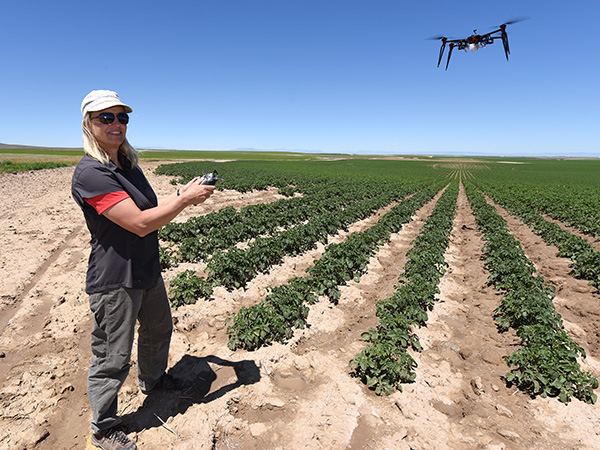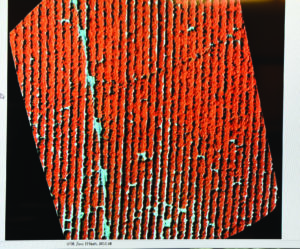
A Deeper Look: Spotting PVY with drones
Seed certification experts gathered at this year’s Potato Expo in Orlando, Florida and discussed some of the challenges facing seed growers. Those challenges included pests like PVY, potato mop-top virus and bacterial ring rot.
One of the problems these pathogens pose, in particular, is in certain cases they can’t be detected visually.
“Unfortunately, a lot of the pathogens that are currently causing a lot of problems, we’ve had a shift in the strains, recombinant strains of PVY that don’t express very well, not like the old PVY,” said Neil Gudmestad, professor of plant pathology at North Dakota State University.
He said environmental factors greatly affect how the pathogens express in potato plants, especially with dickeyea which can be particularly ephemeral.
“We have the same thing with bacterial ring rot, it can lay dormant for up to three years, so we can’t rely on visual process to detect it.”
That is especially problematic since, currently, certification is mainly a visual process.
However, it turns out that at least one of these pathogens, PVY, can be spotted just by looking at a plant. The catch? The one doing the looking is a machine.
Donna Delparte, assistant professor in the Department of Geosciences at Idaho State University (ISU) in Pocatello, has been looking into using unmanned aerial vehicles (UAV), or drones, for pest management in potatoes.
“They are very much the future, especially when we’re working on trying to expand the technology and look at new and novel ways to use UAV, such as crop-invasive species,” Delparte said.

by a UAV. Photo: Donna Delparte
Recently, at this year’s Idaho Potato Conference in Pocatello, Jan. 16-18, Delparte gave growers an update on the status of her work, specifically on using an unmanned aerial vehicle to spot PVY infected plants and to record their specific locations for later control measures. In short, the technology works, but while it’s getting closer to being ready for the market, a few challenges still exist.
Using a special camera, it is possible to fly a drone over a field and, within a reasonable level of certainty, determine precise locations of plants that are infected by PVY. Delparte’s team created a profile of what an infected plant looks like when viewed through a special camera, called a hyperspectral camera, which looks at dozens of slices of radiation, well beyond what a human eye can see.
They then took that profile to the field, used it to identify infected plants and ground-truthed it using personnel on the ground, which verified which plants were infected. The researchers used Russet Norkotah plants, since it’s tough to visually spot a PVY infection in this particular variety.
Using machine learning to tune the algorithm that evaluated the plants, the team reached an 89.8 percent success rate. The drone imagery combined with a Real Time Kinematic (RTK) GPS system, provided the location of the PVY infected potato plants.
“Now imagine we send a farmer basically a dot on a map or a GPS that says this is where you should be able to find PVY infected plants and be able to do some sort of mitigation,” Delparte said.
The first challenge is price. The type of camera needed to spot the infected plants, called a hyperspectral camera, costs around $50,000. Delparte said her team looked at whether a less sensitive multispectral camera, which also is less expensive, could also spot the infection, but so far, those tests have been unsuccessful.
The second major challenge to implementing this technology is processing power. A hyperspectral camera creates a huge amount of data that must be processed through an algorithm to determine which plants are infected. Currently the processing power required is more than what growers would have in even a top-of-the-line home computer.
Delparte said the computer her team uses, which has 32 processing cores and 256 gigabytes of RAM, takes around three days to crunch the numbers. For context, the laptop this article was written on has 16 gigabytes of RAM and a two-core processor.
She said there are currently at least two drone data companies interesting in her research, including Ag Pixel and Drone Deploy. The companies process data collected by drones to create maps that can be used by growers to monitor problems in fields and assess possible problems.
Delparte said they’re conducting more trials and looking at building their own camera that could detect PVY but not carry the $50,000 price tag that a full, hyperspectral camera does. Her goals for the future include using a second drone that follows the first “scouting drone” with a control measure to deal with the infection without relying on personnel on the ground.
In addition, her team is looking at the correlation between PVY and rhizoctonia to see if their research could identify other infections.
Delparte said she understands there is skepticism of whether it would be financially worth it for growers to use drone technology to scout their fields for problems.
“If you’re paying $5 an acre for drone data collection, is that giving you back your return on investment,” she said. “And we think with some sort of PVY detection, that really does have that return on investment in that being able to remove those particular plants that are sick means that your seed potato crop has a lower infection rate of this particular virus and that has value that can be passed down the line.”







